
Gian LorenzoBernini was an Italian sculptor and architect. While a major figure in the world of architecture, he was more prominently the leading sculptor of his age, credited with creating the Baroque style of sculpture. As one scholar has commented, "What Shakespeare is to drama, Bernini may be to sculpture: the first pan-European sculptor whose name is instantaneously identifiable with a particular manner and vision, and whose influence was inordinately powerful ..." In addition, he was a painter and a man of the theater: he wrote, directed and acted in plays, for which he designed stage sets and theatrical machinery. He produced designs as well for a wide variety of decorative art objects including lamps, tables, mirrors, and even coaches.

Blessed Ludovica Albertoni is a funerary monument by the Italian Baroque artist Gian Lorenzo Bernini. The Trastevere sculpture is located in the specially designed Altieri Chapel in the Church of San Francesco a Ripa in Rome, Italy. Bernini started the project in 1671, but his work on two other major works—The Tomb of Pope Alexander VII and the Altar of the Blessed Sacrament in St. Peter's Basilica—delayed his work on the funerary monument. Bernini completed the sculpture in 1674; it was installed by 31 August 1674.

The Bust of Giovanni Battisti Santoni is a sculptural portrait by the Italian artist Gian Lorenzo Bernini. Believed to be one of the artist's earliest works, the bust forms part of a tomb for Santoni, who was majordomo to Pope Sixtus V from 1590 to 1592. The work was executed sometime between 1613 and 1616, although some have dated the work as early as 1609, including Filippo Baldinucci. The work remains in its original setting in the church of Santa Prassede in Rome.

The Bust of Cardinal Escoubleau de Sourdis is a marble portrait sculpture by the Italian artist Gian Lorenzo Bernini. Executed in 1622, the work depicts François de Sourdis. It is currently in the Musée d'Aquitaine in Bordeaux, France.
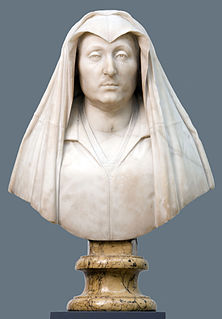
The Bust of Camilla Barbadoni is a marble sculpture by the Italian artist Gian Lorenzo Bernini. Executed in 1619, it portrays the (deceased) mother of the Maffeo Barberini. Camilla had died in 1609. Barberini would become Pope Urban VIII in 1623.

Bust of Giovanni Vigevano is a marble sculptural portrait by the Italian artist Gian Lorenzo Bernini. The bust was produced between 1617 and 1618, and was then inserted into the tomb for Vigevano after he died in 1630. The tomb is in the church of Santa Maria sopra Minerva in Rome.
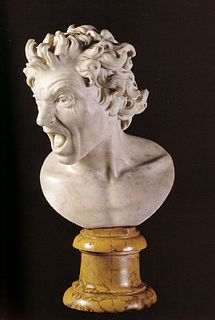
Damned Soul is a marble sculpture bust by the Italian artist Gian Lorenzo Bernini as a pendant piece to his Blessed Soul. According to Rudolf Wittkower, the sculpture is in the Palazzo di Spagna in Rome. This may well be what is known today as the Palazzo Monaldeschi.

The Bust of Alessandro Peretti di Montalto is a portrait sculpture by the Italian artist Gian Lorenzo Bernini. Executed in 1622 and 1623, the sculpture is now in the Kunsthalle Hamburg, in Germany. Although possibly mentioned by one of Bernini's early biographers, the bust had been considered lost and therefore makes no appearance in Rudolf Wittkower's catalogue of Bernini’s sculptures of 1955. However, the bust was identified in the 1980s and is now considered an authentic work by Bernini.
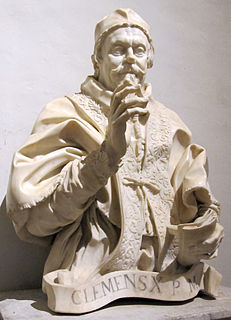
The Statue of Pope Clement X is one of the final sculptural works executed by the Italian artist Gian Lorenzo Bernini. It depicts Pope Clement X in the act of benediction, and is housed in the Galleria Nazionale d'Arte Antica in the Palazzo Barberini, Rome.
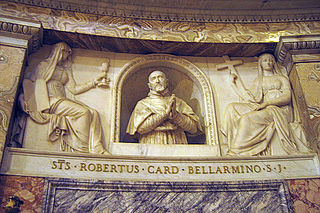
The Bust of Cardinal Roberto Bellarmine is a half-length portrait of Saint Robert Bellarmine by the Italian artist Gian Lorenzo Bernini. It was executed in the years 1621–1624, and unveiled in August 1624. It sits in the Chiesa del Gesù, Rome. It was commissioned by Pope Gregory XV and Cardinal Odoardo Farnese after Bellarmine's death. A tomb (now-destroyed) surrounding the bust was designed by Girolamo Rainaldi, and included sculptural decoration by Bernini's father, Pietro, and Bernini's some-time assistant, Giuliano Finelli.
The Bust of Cardinal Giovanni Dolfin or Delfin is a sculptural portrait by the Italian artist Gian Lorenzo Bernini, which is part of a mausoleum for the Venetian Cardinal Giovanni Delfin, member of one of Venice's most ancient noble families. The tomb as a whole was a joint work commissioned of Bernini and his father Pietro. While Gianlorenzo executed the portrait bust, Pietro carried out the surrounding figures, including two allegorical figures of Faith and Hope as well as the Delfin family coat of arms. The work was completed in late 1621, and sits in the church of San Michele in Isola.

The Blessed Soul is a bust by the Italian artist Gian Lorenzo Bernini. Executed around 1619, it is a pendant piece to the Damned Soul. Their original location was sacristy of the church of San Giacomo degli Spagnuoli, but they were then moved in the late 19th century, and then to the Spanish Embassy to the Holy See in Piazza di Spagna The set may have been inspired by prints by Karel van Mallery, although they were initially categorized as nymph and satyr.
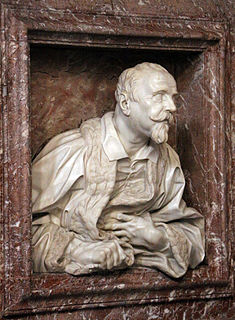
The Bust of Gabriele Fonseca is a sculptural portrait by the Italian artist Gian Lorenzo Bernini. Executed sometime between 1668 and 1674, the work is located in San Lorenzo in Lucina in Rome, Italy. Gabriele Fonseca was the doctor to Pope Innocent X.

The Bust of Antonio Barberini is a portrait sculpture by the Italian artist Gian Lorenzo Bernini. The figure is Cardinal Antonio Barberini, the younger brother of the Pope Urban VIII. It was executed some time in the 1620s.

The Busts of Pope Innocent X are two portrait busts by the Italian artist Gianlorenzo Bernini of Pope Innocent X, Giovanni Battista Pamphili. Created around 1650, both sculptures are now in the Galleria Doria Pamphili in Rome. Like the two busts of Cardinal Scipione Borghese, it is believed that Bernini created a second version of the bust once a flaw was discovered in the first version. There exist several similar versions of the bust done by other artists, most notably Alessandro Algardi.

The Bust of Cardinal Melchior Klesl is a life-size marble bust of the seventeenth-century cardinal by Gianlorenzo Bernini and his assistants, notably Giuliano Finelli. It was probably executed in 1626. It is unclear how much of the work was executed by Bernini and how much by Finelli, or indeed others in Bernini's studio. The sculpture is part of Klesl's tomb in the cathedral of Wiener Neustadt, just south of Vienna.

The Tomb of Countess Matilda of Tuscany is a large sculptural memorial designed by the Italian artist Gianlorenzo Bernini and executed by Bernini and various other sculptors. It was commissioned by Pope Urban VIII in 1633 and was destined for St. Peter's, Rome, where it still sits now. The final parts were completed in 1644.
The busts of Paolo Giordano and Isabella Orsini are two sculptural portraits of the Duke of Bracciano and his wife Isabella Orsini. They were carried out by the Italian artist Gianlorenzo Bernini and members of his studio. Executed around 1635, the two sculptures remain in the Castello Orsini-Odescalchi in Bracciano, Italy.

The Raimondi Chapel is a chapel within the church of San Pietro in Montorio, Rome, Italy. The chapel houses the tombs of two members of the Raimondi family, Francesco and Raimondo. Both the architectural and sculptural elements of the chapel were designed by the artist Gianlorenzo Bernini - it was one of Bernini's first works where the relationship between the sculpture and the architecture was considered as a whole. Elements of the sculptures were executed by other artists in Bernini's circle; Andrea Bolgi did the busts of the two Raimondi brothers and the accompanying putti. Niccolò Sale undertook the reliefs on the tombs, while Francesco Baratta did the larger relief in the central altar. Work on the chapel took place between 1638 and 1648.

















